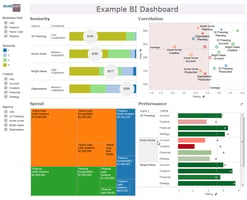Adopting the world's best BI tools enables Decideware to help clients optimize their agency...
Production Transparency . . . What's the Real Problem
On February 22nd and 23rd, the Association of National Advertisers (ANA) held the annual combined meeting of their Production Management and West Coast Advertising Financial Management committees.
As part of that meeting, Steven Wales, CRO of Decideware, presented the case that an important transparency issue is around "ownership".
To fully understand the transparency issue, one must take a step back and understand what transparency actually means. We also need to understand how we developed into this current state where transparency is questioned.
Webster's Dictionary defines transparency as:
- readily understood
- characterized by visibility or accessibility of information especially concerning business practices

So, the big question is: how many brands readily understand or have visibility and access to information about their production spend?
While many advertisers have relationships with valuable production supply chain partners, a majority of the companies represented at this ANA meeting said they don't have ready access to the views of their data that they would prefer to see.
The good news is that there are 3 steps to get any client moving in the right direction. This is not an exhaustive list, but rather a starting point to get you thinking:
Step 1: Standardize
- the production process from a creative idea to a fully executed produced asset across all brands, business units, agencies and geographical regions.
- data collection in terms of how the data gets captured, by whom and when.
- the level of detail that is captured about the production. This may include all 321+ lines of an AICP form or any subset of that detail. The key is to determine what's right for you and then remain diligent about consistently capturing the detail.
Step 2: Centralize
- the data into one central location. This may be a shared spreadsheet on a corporate server or a purpose-built fully automated production management solution (like Decideware’s Production Manager) capturing all production data into one place will allow for analysis, reporting and provide greater transparency.
- the production calendar to gain global or multi-supplier visibility into when, where and by whom various productions are being shot and worked on.
- an external suppliers list of suppliers that are working for your agencies and/or decoupled production partners who you don't have direct business relationships with. This allows for strategic sourcing techniques to be utilized with these third party suppliers to ensure the right companies are working on your business.
Step 3: Analyze
- the costs for production at every level that's relevant to you. This includes the details of every triple bid to ensure the right partners are working on the right jobs at the right cost.
- the suppliers to ensure you're applying strategic sourcing technics for all suppliers working on a given job. This may include eliminating suppliers who are constantly under bidding and then over charging. Or recognizing suppliers/directors/producers who you may award more work based on previous success.
- actuals to budget to understand why overages occurred and how to correct them in the future. You can also understand those jobs that came in under budget and analyze why this happened and if it's repeatable.
Taking the above steps will allow clients to secure direct visibility into their production data and to make



